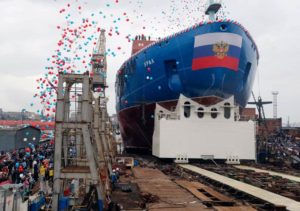Ural: Nuclear-powered Arctic icebreaker launched by Russia
Russia recently launched nuclear-powered Arctic icebreaker named ‘Ural’ at Baltic Shipyard in St. Petersburg. The move is to tap commercial potential of Arctic Ocean.
Key Highlights
- Background: Russian President Vladimir Putin announced in April 2019 that Russia will step up construction of icebreakers with aim of significantly boosting freight traffic along its Arctic coast.
- About: The ship, named as ‘Ural’ was floated out from a dockyard at Baltic Shipyard in St Petersburg. It is one of the trio which when completed will be largest and most powerful icebreakers in world.
- Objective: Launch of Ural, the Nuclear-powered icebreaker ship is part of an ambitious programme to renew and expand Russia’s fleet of vessels in order to improve its ability to tap the benefits of Arctic’s commercial potential and ensuring dominance of Russia in Arctic region.
- The Trio: Ural is one of a trio amongst World’s largest and most powerful icebreakers, other two being Arktika (Arctic) and Sibir (Siberia). The Ural will be handed over to Rosatom (Russia’s state-owned nuclear energy corporation) in 2022 after the other two icebreakers in the same series, Arktika (Arctic) and Sibir (Siberia) enter service.
- Reason: Russia is overhauling its ports and building new infrastructure because during warmer climate cycles, the country readies for more traffic via the Northern Sea Route (NSR) which it envisages being navigable all year-round. The Ural together with its sisters are central to Russia’s strategic project of opening NSR to all-year activity.
- Significance: The drive is part of a push to strengthen Russia’s hand in High North as it seeks for dominance with traditional rivals the United States, Canada and Norway and also newcomer China.
- Way Forward: As per President Vladimir Putin by 2035, Russia’s Arctic fleet would operate at least 13 heavy-duty icebreakers, nine out of which would be powered by nuclear reactors.
Importance of Northern Sea Route (NSR)
- According to a U.S. Geological Survey estimates, the Arctic region has about 22% of the world’s undiscovered oil and gas and it probably holds oil and gas reserves equivalent to 412 billion barrels of oil.
- The NSR runs from Murmansk to the Bering Strait near Alaska. Russia hopes that this NSR could take off as it cuts sea transport times from Asia to Europe.
Month: Current Affairs - May, 2019


